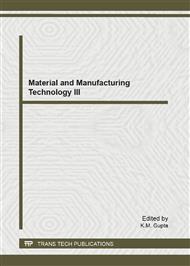[1]
E Harari, et al., Dielectric breakdown in electrically stressed thin films of thermal SiO2, Journal of Applied Physics, 1978, 2478-2489.
DOI: 10.1063/1.325096
Google Scholar
[2]
D J Dumin, R S Ccott, R Subramoniam., A model relating wearout induced physical changes in thin oxides to the statistical description of breakdown, IEEE IRPS, 1993, 302-309.
DOI: 10.1109/relphy.1993.283286
Google Scholar
[3]
P P Apte, et al., Correlation of trap generation to charge-to-breakdown(Qbd): A physical-damage model of dielectric breakdown, IEEE Trans. Electron Devices, 1994, 41, 1595-1602.
DOI: 10.1109/16.310111
Google Scholar
[4]
I C Chen, C Hu., Electric breakdown in thin gate and tunneling oxide, IEEE Trans. Electron Devices, 1985, 32, 413-422.
DOI: 10.1109/t-ed.1985.21957
Google Scholar
[5]
C F Chen, C Y Wu, The dielectric reliability of intrinsic thin SiO2 films thermally grown on a heavily doped Si substrate characterization and model, IEEE Trans. Electron Devices, 1987, 1540-1551.
DOI: 10.1109/t-ed.1987.23117
Google Scholar
[6]
J J Tzon. Temperature dependence of charge generation and breakdown in SiO2, IEEE Electron Devices Letters, 1986, 446-449.
Google Scholar
[7]
D J Dimaria. Impact ionization, trap generation, degradation and breakdown in silicon dioxide films on silicon, Journal of Applied Physics, 1993, 3367-3384.
DOI: 10.1063/1.352936
Google Scholar
[8]
I C Chen, C Hu, Oxide breakdown dependence on thickness and hole current enhanced reliability of ultra thin oxides, IEEE International Electron Device Meeting, 1986, 660-665.
DOI: 10.1109/iedm.1986.191278
Google Scholar
[9]
B Ricco, Novel mechanism for tunneling and breakdown of thin SiO2 films, Phy. Rev. Lett., 1983, 1795-1798.
Google Scholar
[10]
D L Crook, Method of determining reliability screens for time dependent dielectric breakdown, IEEE International Reliability Physics Symposium, 1979, 1-7.
DOI: 10.1109/irps.1979.362863
Google Scholar
[11]
J W McPherson, Underlying physics of the thermochemical E model in describing low-field time-dependent dielectric breakdown in SiO2 thin films,Journal of Applied Physics, 1998, 1513-1523.
DOI: 10.1063/1.368217
Google Scholar
[12]
J W McPherson, J Kim, et. al., Proposed universal relationship between dielectric breakdown and dielectric constant, IEDM Technical Digest, 2002, 633-636.
DOI: 10.1109/iedm.2002.1175919
Google Scholar
[13]
J W McPherson, Determination of the nature of molecular bonding in silica from time-dependent dielectric breakdown data, Journal of Applied Physics, 2004, 8101-8109.
DOI: 10.1063/1.1728288
Google Scholar


